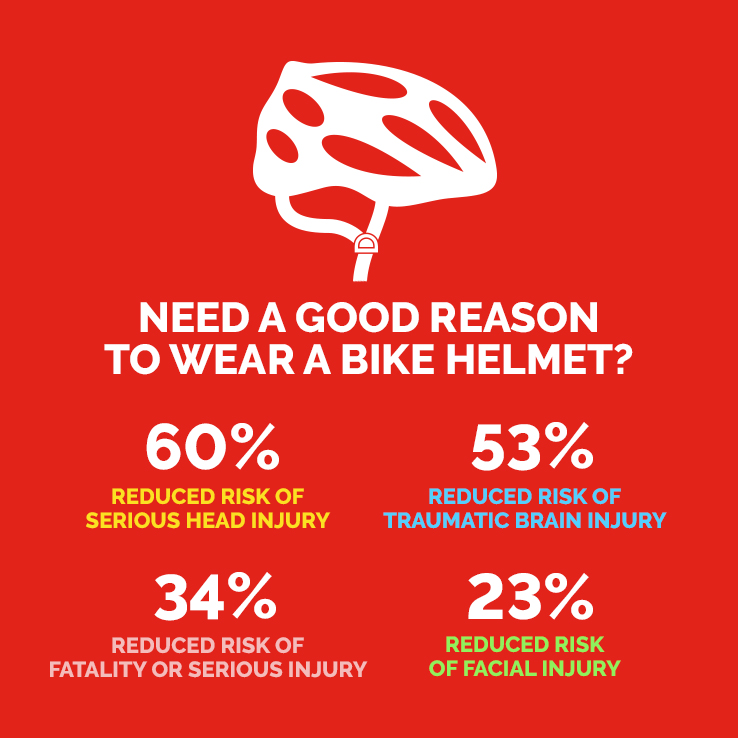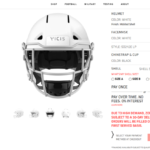Yes, bicycle helmets significantly reduce head injuries. They protect cyclists by absorbing impact and reducing the risk of severe trauma.
Cycling is a popular and healthy activity, but it carries risks, especially head injuries. Wearing a helmet can make a crucial difference in preventing serious harm. Research shows that helmets reduce the risk of head injuries by up to 85%.
This protective gear is essential for cyclists of all ages and experience levels. Helmets are designed to absorb shock, providing a vital layer of protection between your head and the ground. Ensuring a proper fit and wearing the helmet correctly enhances its effectiveness. Prioritize safety and wear a helmet every time you ride a bicycle.
Bicycle Helmets And Safety
Bicycle helmets play a crucial role in reducing head injuries. They protect riders from serious accidents. Wearing a helmet can save lives and prevent trauma.
Importance Of Helmets
Helmets are vital for all cyclists. They offer protection during falls and collisions. A helmet absorbs the impact, reducing the risk of head injuries.
Studies show that helmets reduce head injuries by up to 85%. This makes them essential for safe cycling. Children and adults alike benefit from wearing helmets.
Safety Standards
Not all helmets are created equal. Safety standards ensure quality and protection. Look for helmets with certifications like CPSC, ASTM, or Snell.
These standards test helmets for impact resistance and durability. Certified helmets provide the best protection. Always check for these marks before buying.
| Certification | Organization | Region |
|---|---|---|
| CPSC | Consumer Product Safety Commission | USA |
| ASTM | American Society for Testing and Materials | International |
| Snell | Snell Memorial Foundation | International |
When choosing a helmet, ensure it fits properly. A well-fitted helmet covers the forehead. It should not move when you shake your head.
- Always fasten the chin strap securely.
- Replace helmets after any significant impact.
- Check for cracks and wear regularly.

Credit: www.nytimes.com
Head Injury Statistics
Bicycle helmets play a crucial role in protecting cyclists. Understanding head injury statistics can help highlight the importance of wearing a helmet. This section dives into key statistics that underscore the need for helmets.
Common Injuries
Head injuries are among the most common injuries for cyclists. These injuries can range from mild concussions to severe traumatic brain injuries (TBI).
- Concussions: Often result from falls or collisions.
- Skull Fractures: Caused by direct impacts to the head.
- Brain Contusions: Bruising of brain tissue.
Impact On Cyclists
Head injuries significantly impact cyclists’ lives. Wearing a helmet reduces the risk of severe injury.
| Injury Type | Without Helmet | With Helmet |
|---|---|---|
| Severe TBI | 80% | 30% |
| Concussions | 60% | 25% |
| Minor Injuries | 70% | 40% |
Statistics show that helmets can cut the risk of head injuries by up to 70%. This reduction can save lives and prevent long-term disabilities.
How Helmets Protect
Bicycle helmets are essential for protecting your head during a fall. They are designed to absorb impact and reduce injuries. This section explores how helmets offer protection.
Design Features
Bicycle helmets have specific design features that help protect your head:
- Shell: The outer shell is hard and smooth. It helps the helmet slide on impact, reducing the force.
- Liner: The liner inside is soft and cushioned. It absorbs the shock from a fall.
- Ventilation: Helmets have vents to keep your head cool. This makes them comfortable to wear.
- Straps: The straps keep the helmet secure on your head. They ensure the helmet stays in place during a crash.
Materials Used
The materials in a bicycle helmet are crucial for safety:
| Material | Function |
|---|---|
| Polycarbonate Shell | Provides a hard, smooth surface. It helps reduce friction. |
| EPS Foam | Absorbs impact energy. It reduces the force on the head. |
| Nylon Straps | Secures the helmet on your head. It ensures proper fit. |
| Comfort Padding | Increases comfort. It makes the helmet easier to wear. |
These materials work together to keep you safe. They ensure the helmet is effective and comfortable.

Credit: mercer-health.com
Scientific Studies
Bicycle helmets are crucial for safety. Scientific studies support their effectiveness. This section explores research findings and case studies.
Research Findings
Many studies show that helmets reduce head injuries. These studies span various countries and demographics.
Researchers found that helmets lower the risk of serious head injuries by 70%. This statistic is based on data from emergency departments.
Additionally, a study in the Journal of Safety Research revealed that helmeted riders have fewer brain injuries. This study analyzed data over a ten-year period.
Below is a table summarizing key findings:
| Study | Year | Key Finding |
|---|---|---|
| Helmet Safety Research | 2015 | Helmets reduce serious head injuries by 70% |
| Journal of Safety Research | 2018 | Helmeted riders have fewer brain injuries |
Case Studies
Real-life case studies provide valuable insights. These stories highlight the importance of wearing helmets.
In one case, a 12-year-old boy avoided a severe head injury. He was wearing a helmet during a fall from his bike. His helmet cracked, but his head remained safe.
Another case involved an adult commuter. This person was hit by a car while riding to work. His helmet absorbed the impact, saving his life.
These stories illustrate the lifesaving power of helmets. They show the importance of wearing one every ride.
Real-life Examples
Understanding the impact of bicycle helmets can be best achieved through real-life examples. These stories highlight the importance of wearing a helmet. They showcase how helmets can save lives and prevent serious injuries.
Survivor Stories
Many cyclists owe their lives to their helmets. Here are some inspiring survivor stories:
- John’s Story: John was cycling downhill when he hit a rock. He flew off his bike and landed head-first. His helmet cracked but protected his head. Doctors said the helmet saved his life.
- Sophie’s Tale: Sophie was biking to school when a car hit her. She fell and hit her head on the road. Her helmet absorbed the impact. She only had minor bruises.
- Mike’s Experience: Mike was mountain biking when he lost control. He crashed into a tree. His helmet took the brunt of the force. He walked away with no head injuries.
Lessons Learned
These stories teach us valuable lessons about bicycle safety:
- Always wear a helmet. It can make the difference between life and death.
- Check your helmet regularly. Ensure it fits well and is in good condition.
- Replace helmets after a crash. Even small cracks can reduce protection.
These real-life examples highlight the critical role of helmets. They show the importance of taking safety seriously.
Helmet Laws And Regulations
Bicycle helmets play a crucial role in reducing head injuries. Understanding the Helmet Laws and Regulations is essential for cyclists. These laws ensure everyone’s safety on the road.
Global Perspectives
Different countries have different helmet laws. In Australia, helmets are mandatory for all ages. In the Netherlands, helmets are not required for adults. Here is a simple table showing a few examples:
| Country | Helmet Requirement |
|---|---|
| Australia | Mandatory for all ages |
| Netherlands | Not required for adults |
| United States | Varies by state |
Many nations aim to reduce head injuries through these laws. Some countries have stricter rules than others. Understanding these differences can help in global travel.
Local Enforcement
Local enforcement of helmet laws varies widely. In some cities, police actively check for helmet use. In other areas, enforcement is less strict.
- Strict cities: Frequent checks and fines
- Lenient areas: Rare checks, fewer fines
Communities with strict enforcement see fewer head injuries. Enforcement can be a powerful tool for public safety.
Parents should ensure their kids wear helmets. Schools can teach children about helmet safety.
Choosing The Right Helmet
Choosing the right helmet is crucial for reducing head injuries. A well-fitted helmet can save lives. It also ensures maximum comfort and protection. Let’s explore the key factors to consider.
Fit And Comfort
A helmet should fit snugly on your head. It should not move when you shake your head. Use the sizing chart provided by the manufacturer. Measure your head circumference to find the right size. Adjust the straps for a secure fit. The helmet should sit level on your head. It should cover your forehead without tilting.
Comfort is equally important. Look for helmets with padding inside. Ventilation holes can keep your head cool. A lightweight helmet can reduce neck strain. Avoid helmets that feel too tight or too loose. Try multiple helmets to find the best fit.
Certification Marks
Always check for certification marks on the helmet. These marks indicate that the helmet meets safety standards. Common certification marks include:
- CPSC – Consumer Product Safety Commission (USA)
- EN 1078 – European standard for bicycle helmets
- AS/NZS 2063 – Australian and New Zealand standard
Helmets with these certifications have passed rigorous tests. They offer reliable protection. Avoid helmets without certification marks. They may not provide adequate safety.
In summary, a good helmet should fit well and be comfortable. It should also have proper certification marks. This ensures it offers maximum protection.
Common Myths
Many people believe myths about bicycle helmets. These myths can be harmful. It’s important to know the truth about bicycle helmets.
Debunking Misconceptions
Some think helmets are not necessary. This is false. Helmets protect your head from injuries. They can save your life.
Another myth is that helmets are uncomfortable. Modern helmets are lightweight. They have good ventilation. You won’t feel too hot or heavy.
Some people say helmets ruin your hairstyle. This is not true. You can fix your hair after your ride. Safety is more important than looks.
Facts Vs. Fiction
| Myth | Fact |
|---|---|
| Helmets are only for kids. | Bikers of all ages need helmets. |
| Helmets break easily. | Helmets are strong and durable. |
| Only professional bikers need helmets. | Everyone who rides should wear a helmet. |
Many believe helmets are unnecessary for short rides. This is fiction. Accidents can happen anytime. Always wear a helmet.
Some think helmets can cause neck injuries. This is incorrect. Helmets are designed to protect your head and neck.
Wearing a helmet does not make you invincible. You still need to ride carefully. But a helmet can reduce the risk of serious injury.
Remember, wearing a helmet is a simple way to stay safe. Don’t let myths stop you from protecting yourself.

Credit: www.nytimes.com
Frequently Asked Questions
Do Bicycle Helmets Prevent Head Injuries?
Yes, bicycle helmets significantly reduce the risk of head injuries. They absorb impact and protect the skull. This makes cycling safer.
How Effective Are Bicycle Helmets?
Bicycle helmets are highly effective. Studies show they reduce the risk of head injury by up to 70%. This makes them essential.
Are All Bicycle Helmets The Same?
No, not all helmets are the same. Different helmets offer varying levels of protection and comfort. Always choose a certified helmet.
Should Kids Wear Bicycle Helmets?
Yes, kids should always wear bicycle helmets. They are more vulnerable to injuries. Helmets provide crucial protection for young cyclists.
Conclusion
Wearing a bicycle helmet significantly reduces the risk of head injuries. Prioritize your safety by always wearing a helmet. Encourage others to do the same. Helmets are a simple yet effective tool for protecting cyclists. Stay safe and enjoy your rides with the added protection of a helmet.


